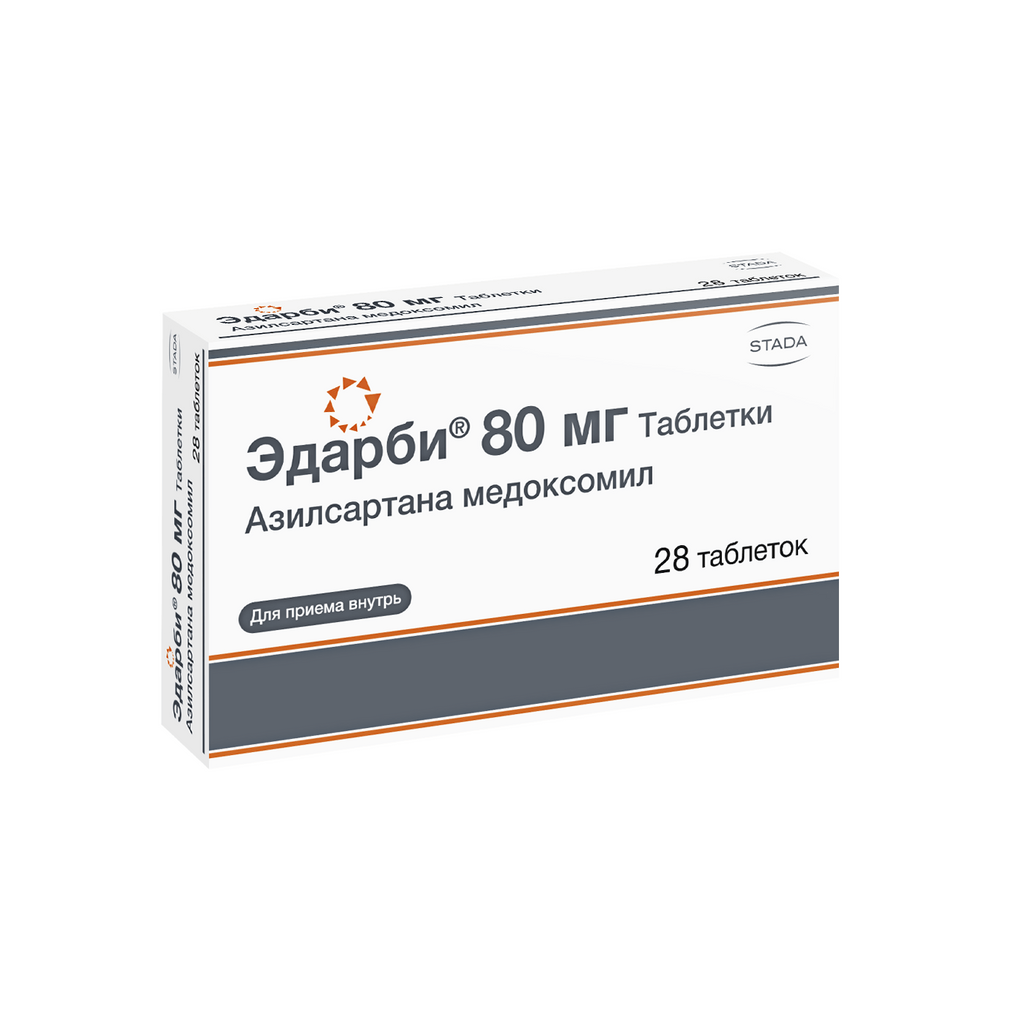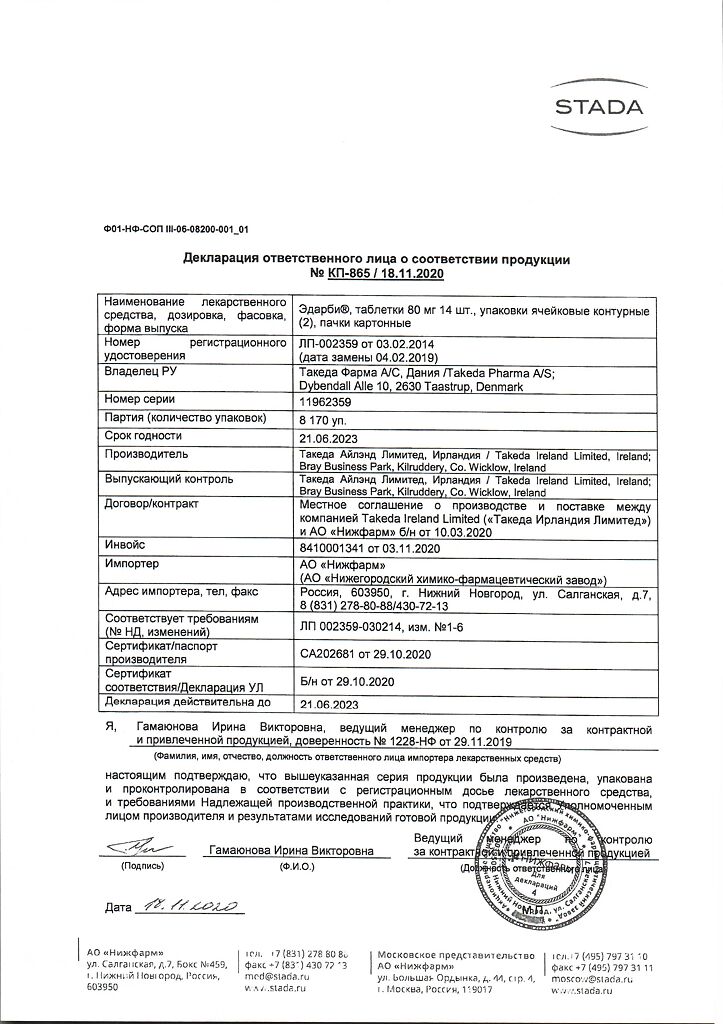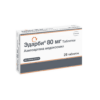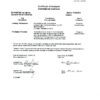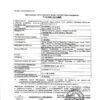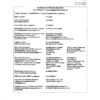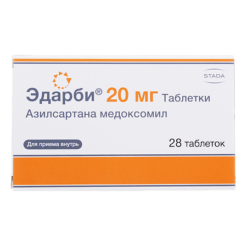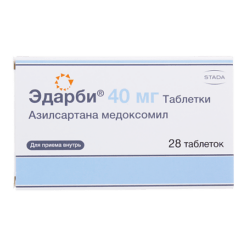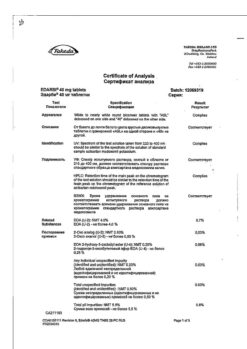No products in the cart.
Edarbi, tablets 80 mg 28 pcs
€36.84 €30.70
Description
An angiotensin II receptor antagonist. Azilsartan medoxomil is an oral active prodrug that is rapidly converted to active azilsartan by blocking its binding to AT1 receptors in various tissues. Angiotensin II is the main pressor of the renin-angiotensin system with effects including vasoconstriction, stimulation of aldosterone synthesis and release, stimulation of cardiac activity and renal sodium reabsorption.
Blockade of AT1 receptors inhibits the inverse suppressive effect of angiotensin II on renin secretion, but the subsequent increase in circulating plasma renin and angiotensin II concentrations does not override the antihypertensive effect of azilsartan.
When using Edarbi™ in the therapy of arterial hypertension, typical BP dynamics are as follows:
– Mean daily systolic BP decreases by 12.2 mm Hg when taking 20 mg, by 13.4-135 mm Hg when taking 40 mg, by 14.5-14.6 mm Hg when taking 80 mg;
– office systolic BP decreases by 14.3 mm Hg when taking 20 mg, by 14.5-16.4 mm Hg when taking 40 mg, by 16.7-17.6 mm Hg when taking 80 mg.
The hypotensive effect of Edarbi™ is maintained for 24 h after administration.
There is no ricochet hypertension after discontinuation of therapy.
The concomitant administration of Edarbib™ 40 and 80 mg with calcium channel blockers (amlodipine) or thiazide diuretics (chlorthalidone) resulted in additional BP reduction compared to other antihypertensive agents as monotherapy.
Dose-dependent adverse effects, including dizziness, hypotension, and increased serum creatinine concentrations, were more frequently observed when concomitantly administered with diuretics compared to administration of Edarbi™ as monotherapy, and hypokalemia was less frequently observed compared to diuretic monotherapy.
The effect on cardiac repolarization:
There was no evidence of prolongation of QT/QTc intervals when Edarbi™ was administered at doses up to 320 mg/day.
Pharmacokinetics:
After oral administration of azilsartan, medoxomil is rapidly hydrolyzed to active azilsartan in the GI tract and/or during absorption. Based on in vitro studies, carboxymethylene butenolidase has been found to be involved in hydrolysis in the intestine and liver. In addition, plasma esterases are involved in the hydrolysis of azilsartan medoxomil into azilsartan.
The estimated absolute bioavailability of azilsartan medoxomil based on plasma concentrations of azilsartan is approximately 60%. After oral administration of azilsartan medoxomil, the Cmax of azilsartan in plasma is reached within 1.5-3 hours. Food has no effect on the bioavailability of azilsartan.
The Vd of azilsartan is approximately 16 liters. Azilsartan is highly bound to plasma proteins (>99%), mainly to serum albumin. Protein binding is constant at plasma concentrations of azilsartan well above the range achieved at recommended doses. Css of azilsartan is reached within 5 days and there is no plasma cumulation with repeated doses once daily.
Dose proportionality in exposure is established for azilsartan at a dose of azilsartan medoxomil from 20 mg to 320 mg after single or multiple doses.
Asilsartan is metabolized to two major metabolites. The main metabolite in plasma is formed by O-dealkylation and is called metabolite M-II; the second metabolite M-I is formed in lower concentration by decarboxylation. The systemic effects of both metabolites in humans are approximately 50% and less than 1% as such of azilsartan, respectively. M-I and M-II are not involved in the pharmacological activity of Edarbi™. The main enzyme responsible for the metabolism of azilsartan is CYP2C9.
After an oral dose of 14C-labeled azilsartan medoxomil, approximately 55% of the radioactivity is evident in the feces and approximately 42% in the urine; 15% of this dose is excreted in the urine as azilsartan. The T1/2 of azilsartan is approximately 11 h and renal clearance is approximately 2.3 mL/min.
Pharmacokinetics in special patient groups:
The pharmacokinetics of azilsartan in young (age 18-45 years) and elderly (age 65-85 years) patients are not significantly different.
No increase (+5%) in exposure has been observed in patients with end-stage renal disease on dialysis. However, there is no clinical experience with use in patients with severe renal failure or terminal renal disease. Hemodialysis does not remove azilsartan from the systemic blood stream.
The administration of Edarbi™ for up to 5 days in patients with mild (Child-Pugh A) or moderate (Child-Pugh B) hepatic impairment resulted in a slight increase in azilsartan exposure (AUC increased 1.3-1.6-fold). The pharmacokinetics of Edarbi™ in patients with severe hepatic impairment have not been studied.
The pharmacokinetics of azilsartan in men and women are not significantly different. There is no need to adjust the dose according to sex.
Indications
Indications
Treatment of essential hypertension in adults.
Pharmacological effect
Pharmacological effect
ATX code: C09CA09
Pharmacotherapeutic group: angiotensin II receptor antagonist.
Pharmacological properties
Pharmacodynamics
Azilsartan medoxomil, the active ingredient of Edarbi®, is a specific antagonist of angiotensin II type 1 (AT1) receptors. Azilsartan medoxomil is an oral prodrug. Azilsartan medoxomil fast
is converted into the active azilsartan molecule, which selectively prevents the development of the effects of angiotensin II by blocking its binding to AT1 receptors in various tissues. Angiotensin II is the primary vasoactive hormone of the renin-angiotensin-aldosterone system (RAAS) with effects including vasoconstriction, cardiac stimulation,
synthesis and release of aldosterone, and, as a consequence, renal reabsorption
sodium.
AT1 receptor blockade inhibits the negative regulatory response of angiotensin II to renin secretion, but the resulting increase in plasma renin activity and circulating angiotensin II levels does not suppress the antihypertensive effect of azilsartan.
The antihypertensive effect of azilsartan medoxomil develops during the first 2 weeks of use with the maximum therapeutic effect achieved after 4 weeks. Decrease in blood pressure (BP) after oral administration of a single dose of
dosage is usually achieved within a few hours and maintained for 24 hours.
“Withdrawal” syndrome (a sharp increase in blood pressure after discontinuation of the drug) after sudden withdrawal after long-term therapy (for 6 months) with Edarbi® was not observed.
The safety and effectiveness of the drug do not depend on the age of the patients, but greater sensitivity to lowering blood pressure in some elderly patients cannot be excluded. As with other angiotensin II receptor antagonists and angiotensin-converting enzyme (ACE) inhibitors, the antihypertensive effect is less pronounced in black patients
(usually a population with low plasma renin activity).
Angiotensin-converting enzyme inhibitors and angiotensin II receptor antagonists should also not be used concomitantly in patients with diabetic nephropathy.
The simultaneous use of Edarbi® 40 mg and 80 mg with dihydropyridine blockers of “slow” calcium channels (amlodipine) or thiazide diuretics (chlorthalidone) leads to an additional decrease in blood pressure compared to antihypertensive drugs used in monotherapy (see section Interaction with other drugs).
Influence on repolarization processes
The potential of Edarby® to prolong the QT/QTc interval was assessed in healthy volunteers during a QT/QTc study. When using a dose of 320 mg Edarbi®, no increase in the QT/QTc interval was noted.
QTc – corrected (relative to heart rate (HR)) value of the QT interval, relative value.
Since the duration of the QT interval depends on the heart rate (lengthening as it slows down), it must be corrected for heart rate to be assessed.
Prolongation of the QT interval reflects the heterogeneity of the processes of repolarization of the ventricular myocardium, and is regarded as an independent indicator indicating the possibility of fatal cardiac arrhythmias.
Pharmacokinetics
Suction
Azilsartan medoxomil is a prodrug. After oral administration, it is converted to the pharmacologically active metabolite azilsartan during absorption from the gastrointestinal tract under the action of the enzyme carboxymethylenebutenolidase in the intestine and liver.
The estimated absolute bioavailability of azilsartan medoxomil when administered orally is approximately 60% based on plasma concentration profiles.
The maximum concentration (Cmax) of azilsartan in blood plasma is on average reached within 1.5-3 hours after taking the drug orally. Food intake does not affect the bioavailability of azilsartan.
Distribution
The volume of distribution of azilsartan is about 16 liters. Azilsartan binds to blood plasma proteins (more than 99%), mainly to blood plasma albumin.
The binding to plasma proteins remains constant when the concentration of azilsartan in the blood plasma significantly exceeds the range achieved when taking recommended doses.
There are no data on the use of the drug during pregnancy and breastfeeding. Azilsartan crosses the placenta of pregnant rats and is excreted into the milk of lactating rats (see section Use during pregnancy and breastfeeding).
Studies in radioactively tagged animals have shown that the amount of azilsartan that crosses the blood-brain barrier is minimal.
Metabolism
Azilsartan is metabolized to two primary metabolites primarily in the liver. The main metabolite in blood plasma is formed by O-dealkylation and is designated as metabolite M-II, a minor metabolite is formed
decarboxylation and is designated as metabolite M-I. The AUC (area under the concentration-time pharmacokinetic curve) values for these metabolites in humans are respectively 50% and less than 1% compared to azilsartan.
M-I and M-II do not affect the pharmacological activity of Edarbi®. The main enzyme responsible for the metabolism of azilsartan is the CYP2C9 isoenzyme.
Removal
Azilsartan and its metabolites are excreted from the body, both through the intestines and the kidneys. Studies have shown that after oral administration of azilsartan medoxomil, about 55% (mainly in the form of metabolite M-I) is found in the feces and about
42% (15% in the form of azilsartan, 19% in the form of metabolite M-II) – in the urine. The half-life of azilsartan is approximately
11 hours and renal clearance is about 2.3 ml/min. The equilibrium concentration of azilsartan is achieved within 5 days and its accumulation in the blood plasma does not occur with a single daily use.
Linearity/Nonlinearity
The pharmacokinetics of azilsartan in azilsartan medoxomil are dose proportional over a dose range of 20 mg to 320 mg after single or multiple oral administration.
Pharmacokinetics in special groups
Children
The pharmacokinetics of azilsartan in children under 18 years of age have not been studied.
Elderly patients
The pharmacokinetics of azilsartan in young (18-45 years) and elderly (65-85 years) patients does not differ significantly.
Kidney failure
In patients with mild, moderate and severe renal impairment, AUC was increased by +30%, +25% and +95%, respectively. No increase (+5%) in AUC was observed in patients with end-stage renal disease on hemodialysis. Clinical data on pharmacokinetics in patients with severe or end-stage disease
There are no renal failures.
Azilsartan is not removed from the systemic circulation by hemodialysis.
Liver failure
The use of Edarbi® for more than 5 days in patients with mild (class A on the Child-Pugh scale) or moderate (class B on the Child-Pugh scale) severity of liver failure leads to a slight increase in AUC (1.3-1.6 times, respectively). The pharmacokinetics of Edarbi® in patients with severe (Child-Pugh class C) liver failure have not been studied.
Gender
The pharmacokinetics of azilsartan in men and women is not significantly different.
No dose adjustment is required depending on gender.
Race
The pharmacokinetics of azilsartan do not differ significantly depending on the race of patients. No dose adjustment is required depending on race.
Special instructions
Special instructions
Activated renin-angiotensin-aldosterone system
In patients whose vascular tone and renal function depend to a large extent on the activity of the RAAS (for example, in patients with severe chronic heart failure (NYHA functional class IV), severe renal failure or renal artery stenosis), treatment with drugs acting on the RAAS, such as ACE inhibitors and angiotensin II receptor antagonists, is associated with the possibility of developing acute arterial hypotension, azotemia, oliguria or rarely acute renal failure. The possibility of developing the listed effects cannot exist
excluded when using Edarbi®.
A sharp decrease in blood pressure in patients with ischemic cardiomyopathy or ischemic cerebrovascular diseases can lead to the development of myocardial infarction or stroke.
Kidney transplantation
There are no data on the use of Edarbi® in patients who have recently undergone kidney transplantation.
Liver dysfunction
There are no data on clinical experience with the use of Edarbi® in patients with severe liver dysfunction, therefore the use of the drug in this category of patients is not recommended.
Arterial hypotension due to water-electrolyte imbalance
In patients with reduced blood volume and/or hyponatremia (as a result of vomiting, diarrhea, taking large doses of diuretics, or following a diet with limited sodium intake), clinically significant arterial hypotension may develop after initiation of Edarbi® therapy. Hypovolemia should be corrected before starting treatment with Edarbi® or starting treatment with a dosage of 20 mg.
Primary hyperaldosteronism
Patients with primary hyperaldosteronism are usually resistant to treatment with antihypertensive drugs that affect the RAAS. In this regard, Edarbi® is not recommended for such patients.
Hyperkalemia
Clinical experience with other drugs that affect the RAAS shows that the simultaneous administration of Edarbi® with potassium-sparing diuretics, potassium supplements or salt substitutes containing potassium, or other drugs that can increase the level of potassium in the blood (for example, heparin) can lead to hyperkalemia in patients with arterial
hypertension. Elderly patients, patients with renal failure, diabetes mellitus and/or patients with other concomitant diseases increase the risk of developing hyperkalemia, which can be fatal. Such
Patients are advised to monitor serum potassium levels.
Aortic or mitral valve stenosis, hypertrophic obstructive cardiomyopathy
When prescribing Edarbi® to patients with aortic or mitral stenosis or hypertrophic obstructive cardiomyopathy, caution must be exercised.
Lithium
As with other angiotensin II receptor antagonists, simultaneous use of lithium and Edarbi® is not recommended (see section Interactions with other drugs).
Impact on the ability to drive vehicles and machinery
Based on the pharmacodynamic properties, it is expected that azilsartan medoxomil will have a slight effect on the ability to drive vehicles and operate machinery. Caution must be exercised, as with any antihypertensive drugs (risk of dizziness and fatigue).
Active ingredient
Active ingredient
Azilsartan medoxomil
Composition
Composition
1 tablet 20 mg contains:
Active ingredient: azilsartan medoxomil potassium 21.34 mg corresponds to azilsartan medoxomil 20 mg
Excipients: mannitol 47.815 mg, fumaric acid 1 mg, sodium hydroxide 0.345 mg, hyprolose 2.7 mg, croscarmellose sodium 6.9 mg, microcrystalline cellulose 9 mg, magnesium stearate 0.9 mg.
1 tablet 40 mg contains:
Active ingredient: azilsartan medoxomil potassium 42.68 mg corresponds to azilsartan medoxomil 40 mg
Excipients: mannitol 95.63 mg, fumaric acid 2 mg, sodium hydroxide 0.69 mg, hyprolose 5.4 mg, croscarmellose sodium 13.8 mg, microcrystalline cellulose 18 mg, magnesium stearate 1.8 mg.
1 tablet 80 mg contains:
Active ingredient: azilsartan medoxomil potassium 85.36 mg corresponds to azilsartan medoxomil 80 mg
Excipients: mannitol 191.26 mg, fumaric acid 4 mg, sodium hydroxide 1.38 mg, hyprolose 10.8 mg, croscarmellose sodium 27.6 mg, microcrystalline cellulose 36 mg, magnesium stearate 3.6 mg.
Pregnancy
Pregnancy
Use during pregnancy
Animal studies have shown that azilsartan and M-II cross the placental barrier.
Patients planning pregnancy should begin therapy with alternative antihypertensive drugs with an established safety profile for pregnant women. Immediately after confirmation of pregnancy, you should stop taking Edarbi® and, if necessary, begin a course of treatment with drugs approved for use during pregnancy.
As with any drug that affects the reninangiotensin-aldesterone system (RAAS), fetal damage (renal dysfunction, oligohydramnios, delayed cranial ossification) may occur in the second and third trimester of pregnancy.
If the drug was used in the second and third trimester of pregnancy, it is recommended to conduct an ultrasound examination of the skull and excretory function of the fetal kidneys.
Newborns whose mothers received Edarbi® therapy may develop arterial hypotension, renal failure, and hyperkalemia, and therefore newborns should be under close medical supervision.
Breastfeeding
There is no information on the ability of azilsartan and/or its metabolites to pass into breast milk. Animal studies have shown that azilsartan and M-II are excreted into the milk of lactating rats.
Due to the lack of experience with the use of Edarbi® in women during breastfeeding, its use in this category of patients is not recommended.
It is preferable to use drugs with the best studied safety profile, especially when caring for a newborn or premature baby.
Fertility
There are no data on the effects of Edarbi® on fertility in humans.
Preclinical studies have shown no effect on male or female fertility in rats.
Contraindications
Contraindications
– hypersensitivity to the active substance and other components
drug;
– pregnancy;
– simultaneous use of drugs containing aliskiren in patients with diabetes mellitus and/or moderate and severe renal impairment (glomerular filtration rate (GFR) less than 60 ml/min/1.73 m2 body surface area);
– simultaneous use with ACE inhibitors in patients with diabetic nephropathy;
– age under 18 years (efficacy and safety have not been established);
– severe liver dysfunction (more than 9 points on the Child-Pugh scale) (no experience with use).
With caution:
– severe chronic heart failure (functional class IV according to the NYHA classification);
– severe renal failure (creatinine clearance < 30 ml/min);
– bilateral stenosis of the renal arteries and stenosis of the artery of the only functioning kidney;
– ischemic cardiomyopathy;
– ischemic cerebrovascular diseases;
– condition after kidney transplantation;
– conditions accompanied by a decrease in circulating blood volume (CBV) (including vomiting, diarrhea), as well as in patients on a diet with limited salt;
– when used simultaneously with large doses of diuretics;
– primary hyperaldosteronism;
– hyperkalemia;
– stenosis of the aortic and mitral valves;
– hypertrophic obstructive cardiomyopathy (HOCM);
– age over 75 years.
If you have one of the following diseases, be sure to consult your doctor before taking Edarbi®.
Side Effects
Side Effects
The frequency of adverse reactions was determined in accordance with the recommendations of the World Health Organization: very often (> 1/10); often (> 1/100, 1/1000, 1/10,000, < 1/1000); very rare (<1/10,000), including isolated reports; unspecified frequency (frequency cannot be calculated from available data).Nervous system disorders: Common – Dizziness
Vascular disorders: Uncommon – Marked decrease in blood pressure
Gastrointestinal disorders: Common – Diarrhea, Uncommon – Nausea
Skin and subcutaneous tissue disorders: Uncommon – Rash, itching, Rare – Angioedema
Musculoskeletal and connective tissue disorders: Uncommon – Muscle spasms
Impact on the results of laboratory and instrumental studies: Often – Increased activity of creatine phosphokinase, Infrequently – Increased creatinine concentration, Hyperuricemia
General disorders: Uncommon – Fatigue, peripheral edema.
Description of individual adverse reactions
With simultaneous use of Edarbi® with chlorthalidone, the frequency of adverse reactions – a pronounced decrease in blood pressure and an increase in creatinine concentration – increases in frequency: from infrequent to frequent.
With simultaneous use of Edarbi® with amlodipine, the frequency of an undesirable reaction – peripheral edema – increases from infrequent to frequent, but is less common than with amlodipine monotherapy.
Angioedema, including swelling of the face, lips and periorbital edema, is rare.
As with the use of other angiotensin II receptor antagonists and ACE inhibitors, the simultaneous use of Edarbi® with diuretics (for example, chlorthalidone) leads to an increased incidence of increased creatinine concentrations. An increase in creatinine concentration with simultaneous use of Edarbi® with diuretics is associated with a greater decrease in blood pressure compared with
Edarbi® monotherapy. Most of these effects were short-lived or did not progress as long as patients continued therapy. After discontinuation of the drug, most cases of increase in creatinine concentration that did not go away during treatment were reversible. Creatinine concentrations returned to baseline values in most patients or
values close to the baseline.
When treated with Edarbi®, a slight increase in serum uric acid concentration was observed (10.8 µmol/l) compared to placebo (4.3 µmol/l).
As with the use of other RAAS inhibitors, a slight decrease in hemoglobin and hematocrit was observed in monotherapy (on average they decreased by about 3 g/l and 1 vol.%, respectively).
If any of the side effects indicated in the instructions get worse, or you notice any other side effects not listed in the instructions, tell your doctor.
Interaction
Interaction
Lithium
A reversible increase in serum lithium concentrations and toxicity were observed during concomitant use of lithium preparations and ACE inhibitors and lithium preparations with angiotensin II receptor antagonists.
Therefore, the simultaneous use of azilsartan medoxomil in combination with lithium preparations is not recommended (see section Special instructions). If it is necessary to use appropriate combination therapy, regular monitoring of lithium levels in the blood serum is recommended.
Nonsteroidal anti-inflammatory drugs (NSAIDs)
With the simultaneous use of angiotensin II antagonists and NSAIDs (for example, selective COX-2 inhibitors (cyclooxygenase-2), acetylsalicylic acid (more than 3 g / day) and non-selective NSAIDs), the antihypertensive effect may be weakened. With simultaneous use of angiotensin II antagonists and NSAIDs, the risk of renal dysfunction and an increase in serum potassium may increase. Therefore, at the beginning of treatment, patients are advised to regularly take sufficient fluids and monitor kidney function.
Potassium supplements and potassium-sparing diuretics, heparin
Concomitant use of potassium-sparing diuretics, potassium supplements, salt substitutes containing potassium and other drugs (for example, heparin) with azilsartan medoxomil may lead to an increase in
potassium in blood serum (see section Special instructions). Patients should monitor serum potassium levels during combination therapy.
Dual blockade of the renin-angiotensin-aldosterone system (RAAS)
Dual blockade of the RAAS with angiotensin II receptor antagonists, ACE inhibitors, or drugs containing aliskiren is associated with an increased risk of arterial hypotension, hyperkalemia, and renal dysfunction (including acute renal failure) compared with monotherapy.
Concomitant use of angiotensin II receptor antagonists with drugs containing aliskiren is contraindicated in patients with diabetes mellitus and/or moderate or severe renal impairment (glomerular
filtration less than 60 ml/min/1.73 m2 body surface area) and is not recommended in other patients.
Concomitant use of angiotensin II receptor antagonists with ACE inhibitors is contraindicated in patients with diabetic nephropathy and is not recommended in other patients.
Additional information on interactions between azilsartan medoxomil
No pharmacokinetic interactions were observed with simultaneous use of azilsartan medoxomil or azilsartan with amlodipine, antacids (magnesium and aluminum hydroxide), chlorthalidone, digoxin, fluconazole, glibenclamide, ketoconazole, metformin and warfarin.
Azilsartan medoxomil is converted into the pharmacologically active metabolite azilsartan during absorption from the gastrointestinal tract under the action of the enzyme carboxymethylenebutenolidase in the intestine and liver. In vitro studies have shown that interactions based on enzyme inhibition are unlikely.
Diuretics and other antihypertensive drugs
The antihypertensive effect of azilsartan medoxomil therapy can be enhanced when used in combination with other antihypertensive drugs, including diuretics (chlorthalidone and hydrochlorothiazide), and dihydropyridine calcium channel blockers (amlodipine).
Overdose
Overdose
Experience with the use of Edarbi® in adults in doses up to 320 mg/day for 7 days shows that the drug is well tolerated.
Symptoms: marked decrease in blood pressure, dizziness.
Treatment: If there is a pronounced decrease in blood pressure, place the patient in a “lying” position, raise his legs, and take measures to increase the volume of circulating blood (CBV); monitor vital signs; symptomatic therapy.
Azilsartan is not removed from the systemic circulation by dialysis.
Storage conditions
Storage conditions
Store in original packaging to protect from light and moisture at a temperature not exceeding 25 C.
Keep out of the reach of children.
Shelf life
Shelf life
3 years.
Do not use after the expiration date stated on the package.
Manufacturer
Manufacturer
Takeda Island Limited, Ireland
Additional information
| Manufacturer | Takeda Island Limited, Ireland |
|---|---|
| Medication form | pills |
| Brand | Takeda Island Limited |
Other forms…
Related products
Buy Edarbi, tablets 80 mg 28 pcs with delivery to USA, UK, Europe and over 120 other countries.

